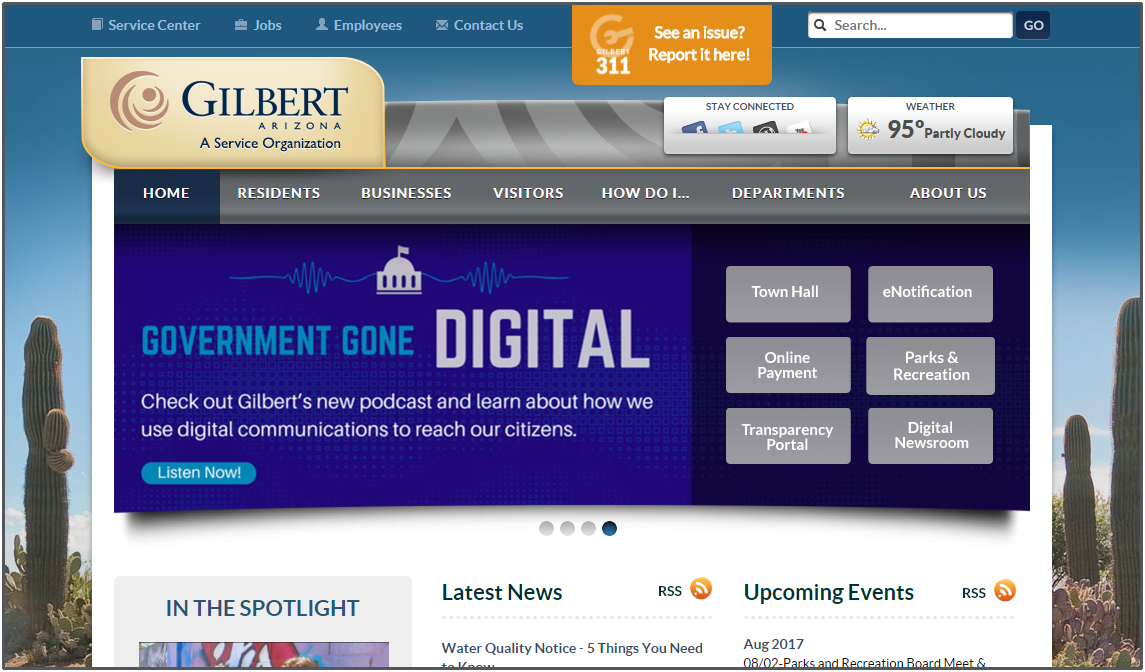
Currently, the most populous incorporated town in the United States, the Town of Gilbert, has an even bigger digital footprint. From Podcasting to Mobile AppHubs, Gilbert’s programs are as impressive as they are comprehensive. We recently spoke with Zara Bish, the town’s Multimedia Specialist about their website redesign, and their strategy for building a digital engagement portal.
What was the catalyst for the website redesign?
When I came aboard the redesign was my first big task. The plan was to work with the IT department, who oversaw the site, on the project. At that time, all the website updates had to roll through one person; which was pretty inefficient. We started assessing the capacity and demand. Ultimately, it evolved into the website coming under the Digital Communications Department and partnering with Granicus.
The old site was outdated UX-wise and functionality-wise. There were no opportunities to create new experiences for the user. It was frustrating for the city and the residents. Internally, departments were going off to create their own websites. If a staff member can do something on their phone, they expect the city to provide the same level of technology. For residents, because of population growth, the demands on the website increased beyond what we could handle. We have lots of new families and businesses! We simply had to advance from a technological perspective because we needed to meet our residents where they were. Part of the advancement morphed into combining website and social media messaging so we could communicate through multiple channels.

Tell me about the process of migrating/rewriting the content from your old site to the new one?
We started with about 5,000 pages and now we are down to about 1,500. A lot of what facilitated that process was how the govAccess CMS was built. Our old site was built in Cold Fusion, so everything was its own page. Granicus’ dynamic page generation and widgets helped a lot. We were also more judicious about what information we displayed, if we really needed it, if it can be combined, etc.
In tandem with the launch of the website, we also rebranded. Rebranding helped to define and make our content message more cohesive, overall, which I plan to document into a more formal policy.
From a content perspective, one of the challenges we face is that we are both a ‘town’ and are large enough to be a city. Different departments have different views on this nomenclature. Parks and rec refers to Gilbert as a ‘town’ because they like the fuzzy feel. But economic development uses ‘city’ because they want more businesses to come here. All of this has really evolved over the past few years.
What measures did you put in place to avoid content bloat?
I would love to work on more policies for content writing. When we launched Granicus, we gave the content owners the freedom to develop their pages. There’s a lot of trust. We’ve done a lot of training. We do a content managers’ newsletter. However, we’ve put some limits into place. For example, I don’t want them to create new pages. I need to be involved if they want to do anything big.
Most municipal websites are based on “what is the content” or “who is looking for the content,” which is yours?
For the most part, I would say we are “who,” but it’s really difficult. We referenced other municipalities and took what we thought would be most successful for our residents.
How do analytics from your site inform your decision making?
I create monthly reports and include them in my newsletter. I pull numbers of users, social site referrals, top pages, bounce rate, etc. It gets the departments thinking about what they are putting on the site. Additionally, I use analytics to help mitigate unnecessary changes that the departments want to make. It stops the “we are-requesting-pages-because-we-are-bored-with-our-pages” requests.
What happens when the analytics don’t reflect what the department wants?
We compromise. As an example, our analytics on the fire station’s homepage showed that the actual location of the station got the most traffic, so I had it up top. But, the fire department has a lot of programs they want to promote so now it’s been pushed down a bit.
How many of your visitors are coming from mobile devices?
About half.
What does the website do for the city?
Our intention for the website is for it to be a citizen engagement tool. We want the resident to come back to the website to find out what is going on as Gilbert is growing quite a bit. We use a lot of video, news, etc. to inform our resident about unfamiliar departments. We have great people working here and great initiatives.
Why did you start podcasting?
My boss, Dana Berchman, was getting a lot of questions and calls from other municipalities about what we were working on in the Digital Communications Office. She decided to podcast as a way to disseminate the information. We just did our 23rd, and they’ve been really well-received.
If, like the town of Gilbert, you are interested in what’s next for local government digital communications check out this blog post.